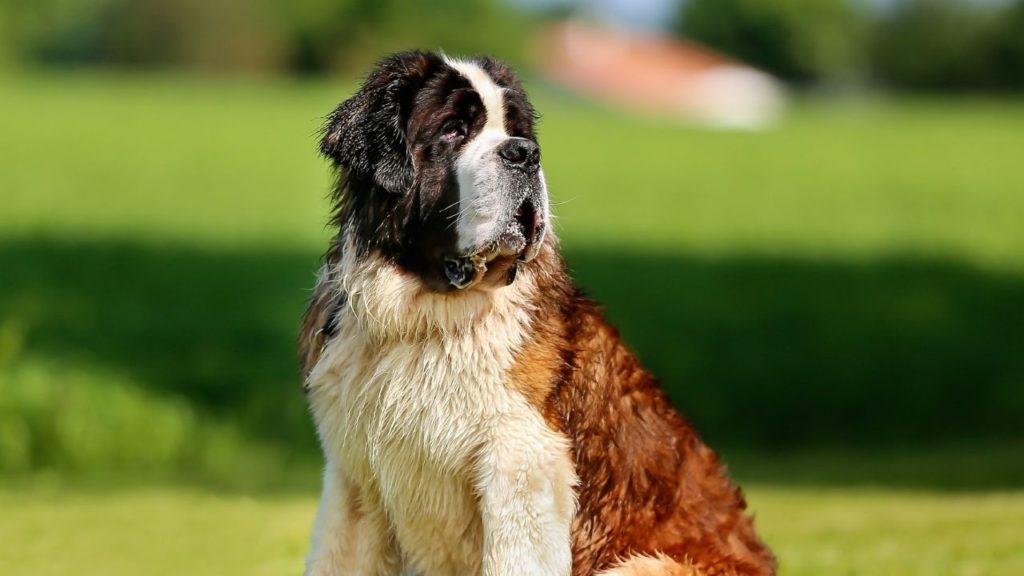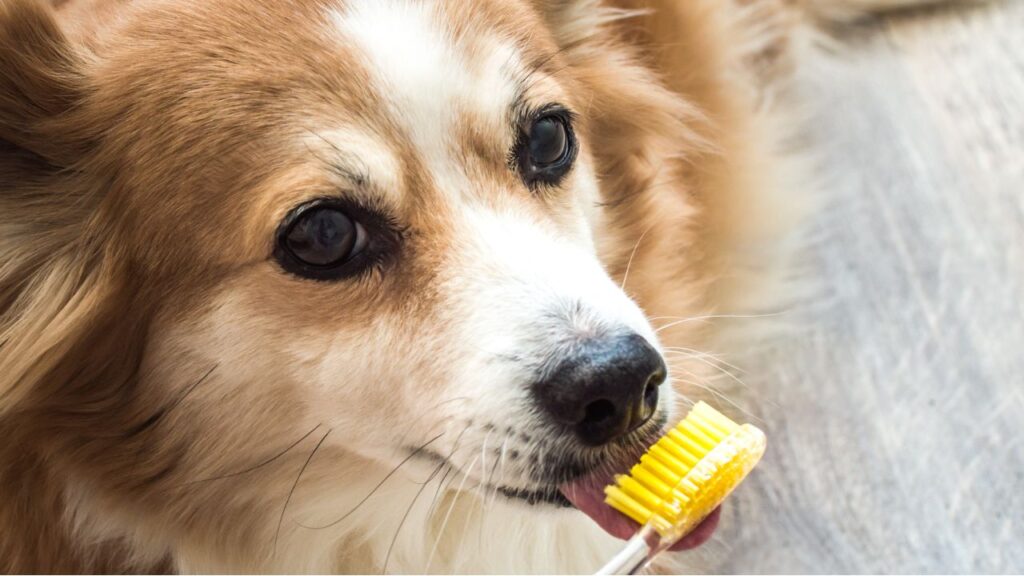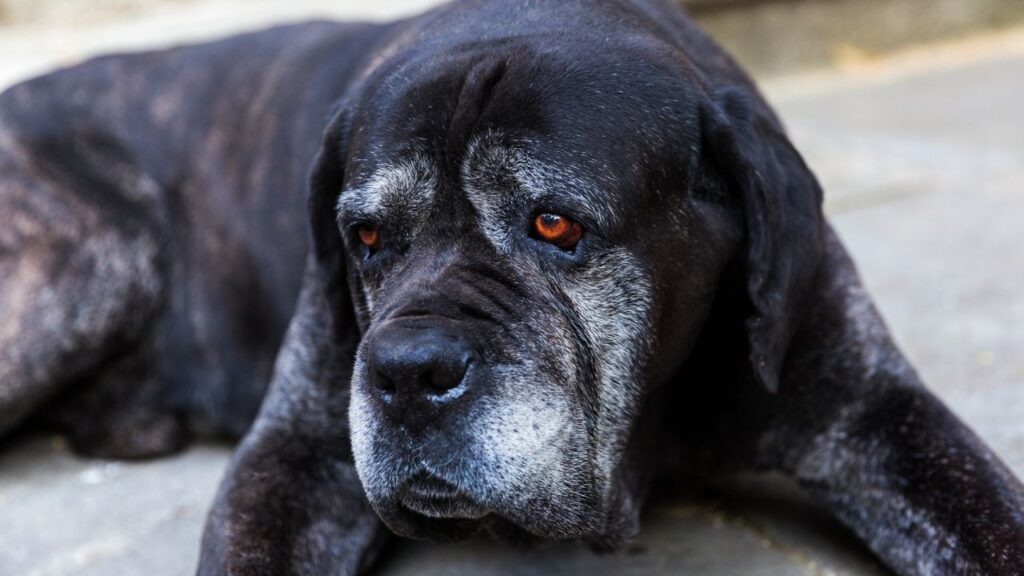There are many types of cancer that occurs in the oral cavity. However, early detection of mouth cancer in dogs leads to a favorable response to treatment and a better prognosis.
Key Takeaways
- There are many different mouth cancer tumor types, and how long a dog lives with mouth cancer varies widely on what type and stage of cancer they have. With prompt treatment, some tumor types have two-year survival rates. Catching it early improves outcomes for all tumor types.
- Mouth cancer in dogs may not be clearly visible if the tumor is towards the back of the mouth. Depending upon the tumor type, you may see a fleshy lump, a black spot, or just irritation.
- Mouth cancer is painful for dogs. If you have ever had a toothache or dental problem, you can imagine how painful a tumor in this area might be.
- Mouth cancer in dogs can be very aggressive. Depending upon the tumor type, they can invade local tissues, including the bones, but they can also spread to other sites in the body. Some tumor types, like oral malignant melanoma, have often already spread at the time of diagnosis.
- Dogs with oral melanoma who do not get treatment have a median survival time of two months. With treatment the prognosis improves.
An Overview of Mouth Cancer in Dogs
There are a variety of different tumor types that can arise in the oral cavity, and different tumor types might act differently. In this article, we will be doing a broad overview of mouth cancer in dogs, with links to more in-depth articles on specific tumor types as necessary.
Mouth Cancers in Dogs Can Occur in Several Cell Types
Many different malignant and benign tumors can develop in the oral cavity because there are several types of cells in the mouth. Oral tumors can be benign (relatively harmless) or malignant (aggressive and prone to spread). The earlier they are found, the more available treatment options and the better the prognosis.1
In dogs, the most common malignant oral tumors in order of frequency are malignant melanoma, squamous cell carcinoma, and fibrosarcoma.
Oral Malignant Melanoma (OMM)
Oral malignant melanoma (OMM) is dogs’ most common oral malignancy.2
It is significant enough that it warrants its own article here on DogCancer.com.
The tumor originates from the proliferation of melanocytes, pigment-producing cells found in the skin, eyes, and the oral cavity.3
OMM is a highly malignant tumor with frequent metastasis (80–100% of cases) to regional lymph nodes and lungs. Metastasis is associated with the tumor’s site, size, and stage. In general, the median survival time of dogs with untreated oral melanomas is two months.4
Squamous cell carcinoma (SCC)
Squamous cell carcinoma (SCC) is a malignant tumor derived from the epithelium of the oral mucosa (cells that line the oral cavity).5
Squamous cell carcinoma associated with the tonsils has a high risk of metastasis6 and frequently invade bone. The most common site of metastasis is the retropharyngeal lymph nodes.4
Oral fibrosarcomas (FSA)
Oral fibrosarcomas (FSA) are malignant, infiltrating, mesenchymal tumors. They are locally invasive but rarely metastasize to regional lymph nodes or the lungs (this happens in less than 30% of cases).
Despite the benign histologic appearance of these tumors (they look benign under a microscope), at times, they tend to grow rapidly and can invade bone. Rapid recurrence is common, with up to 57% returning after removal.
Before 2000, the survival rate for dogs with oral fibrosarcoma was one year, even with treatment, but it has improved in recent years.7
Epulides or Odontogenic Tumors
Another type of mouth cancer in dogs is epulis or odontogenic tumors. These tumors are generally less aggressive, account for roughly 18% of all oral tumors in dogs, and respond well to early treatment.
Veterinary oncologist Dr. Brooke Britton explains why catching oral cancer early is so important on DOG CANCER ANSWERS.
Stats and Facts About Oral Tumors in Dogs
- The oral cavity is the site of approximately 6% of all neoplasms (cancers) in dogs.
- Oral cancer is the fourth most common dog cancer overall.4
- The incidence of malignant oral tumors is higher in dogs age eight and older.24
What Causes Mouth Cancer in Dogs
While we often cannot determine an exact cause for other cancer types, oral tumors have some likely culprits.
Oral tumors are often spontaneous. However, their likelihood of developing is increased by exposure to certain chemical, physical, or microbial mutagens (agents that cause genetic mutations).
In humans, oral squamous cell carcinoma was associated with poor oral hygiene. People who had regular dental care were 62% less likely to be diagnosed with oral squamous cell carcinoma.9
Another report showed that papillomavirus may lead to oral carcinoma in dogs.10
Risk Factors for Mouth Cancer in Dogs
There are a variety of factors that can increase your dog’s risk of developing mouth cancer.
Oral melanoma tends to occur in smaller breed dogs and some large breeds, with an average age of 12 years. Predisposed breeds include:
- Cocker Spaniel
- Miniature Poodle
- Anatolian Shepherd Dog
- Gordon Setter
- Chow Chow
- Golden Retriever
The average age of a dog presenting with an oral squamous cell carcinoma is 8–10 years.
Oral fibrosarcomas tend to occur in large‐breed dogs, particularly the Golden and Labrador Retriever. The average age at presentation is 7–9 years, and it appears that males are predisposed4.
Symptoms of Mouth Cancer in Dogs
The symptoms you might notice at home will vary depending on the location and type of cancer.
If an oral mass is located towards the front of the mouth, it will often be easy to see. Ones located further back in the oral cavity are rarely noticed at home because they are challenging to see. This is why dogs are often diagnosed late when their oral cancer is already advanced.
Signs vary depending on where the tumor is and how big it has grown and may include: 4,24
- Hypersalivation (excess drooling)
- Reluctance to eat
- Exophthalmos (facial swelling)
- Epistaxis (nosebleeds)
- Weight loss
- Halitosis (bad breath)
- Bloody oral discharge
- Dysphagia or (pain on opening the mouth)
- Occasionally, lymph node enlargement (especially in tonsillar squamous cell carcinoma)
Veterinary oncologist Dr. Megan Duffy discusses the financial realities of treating dog cancer on DOG CANCER ANSWERS.
Diagnosing Oral Cancer in Dogs
Your veterinarian will use a variety of tests to determine if your dog’s symptoms are caused by cancer and if so, what type of cancer is present.
Physical Examination
Most veterinarians will want to physically look at your dog’s mouth. Depending upon the tumor location and how happy your dog is to have their mouth examined, they may need to sedate or give your dog general anesthesia.
These tumors are sometimes found during dental cleanings, in which case your veterinarian will usually get a biopsy of anything suspicious while cleaning.
Biopsy or Fine Needle Aspirate
A definitive diagnosis is necessary because the different cancer types that can occur in the mouth have different treatments. If your veterinarian tries an aspirate first, it may be sufficient to get a definitive diagnosis. But if it comes back inconclusive, they will want to do a biopsy to make the best treatment plan.
Biopsy is the best way to get a definitive diagnosis.8 Your dog will need to undergo anesthesia to have a mouth biopsy.
Imaging
Advanced imaging is recommended for oral tumors arising from the maxilla, palate, and parts of the mandible.
Computed tomography (CT) scans are generally preferred over magnetic resonance imaging (MRI). Information obtained from CT or MRI is critical in planning definitive surgery and radiation in these delicate, compact areas.
Three‐view thoracic radiographs (X-rays) are recommended to evaluate your dog for evidence of lung metastasis. Many veterinarians take these before a dental cleaning to ensure the lungs can handle anesthesia, so these may already have been obtained.
Thoracic CT scans of the torso should be considered for animals with highly metastatic tumor types such as oral malignant melanoma,4 to look for spread.
The lymph nodes throughout the body will be evaluated to check for signs of metastasis.
Bloodwork
Complete blood count and blood chemistry will help your veterinarian check your dog’s general health for anesthesia. This may have been done before a dental cleaning, as well.
Ruling Out Lymphoma
If your dog also has bilaterally enlarged tonsils, your veterinarian will want to rule out lymphosarcoma, which also can cause this particular symptom.
Staging and Prognosis for Mouth Cancers in Dogs
Staging may impact your dog’s prognosis, which treatment options are available for your dog, and may also impact your treatment decisions.
Staging of Mouth Cancers
Staging oral tumors includes a thorough physical examination of the oral cavity and regional lymph nodes, three-view thoracic radiographs (X-rays), and complete pre-anesthetic blood tests and heart evaluation, as discussed above.
Any enlarged lymph nodes should be aspirated to help determine the stage. Ideally, the lymph nodes will be removed and biopsied because this is the best way to determine whether cancer has spread to the lymph nodes.7
Based on these diagnostic steps, oral tumors are then staged according to the World Health Organization’s staging scheme:4
- Stage I: less than 2cm diameter tumor
- Stage II: 2 -4cm diameter tumor
- Stage III: larger than 4cm diameter tumor and/or lymph node metastasis
- Stage IV: Distant metastasis
Prognosis for Mouth Cancers
Different mouth cancer tumor types have different prognoses.
Malignant Melanomas
Malignant melanomas are incredibly aggressive. These tumors are highly invasive and frequently metastasize. Surgery can extend survival times and may be curative, but these tumors frequently come back and the prognosis is poor.
Nontonsillar squamous cell carcinomas
Nontonsillar squamous cell carcinomas don’t typically metastasize but are locally invasive. There is a good prognosis with aggressive surgical resection to completely remove the tumor, radiation, or a combination of both. Median survival time ranges from 19 to 26 months following surgery.
Tonsillar Squamous Cell Carcinoma
Tonsillar squamous cell carcinomas are aggressive and have a poor prognosis. Due to higher local recurrence and metastatic rates, studies report one‐year survival rates of only 10%.
Fibrosarcomas
Fibrosarcomas tend to be locally aggressive and have a guarded prognosis. Overall survival improved recently due to better surgical planning (increasing from 247 to 743 days). The major concern in the when it comes to oral fibrosarcoma is the high local rate of recurrence (the tumor coming back).4,7
Treatment for Mouth Cancer in Dogs
Cancer treatment in dogs is not usually about getting a “cure.” Instead, the focus is on improving and maintaining and improving the quality of life while also hopefully extending the dog’s life beyond what would happen if the cancer wasn’t treated.
Pain Management
Life quality concerns are especially important for oral cancers, which are often painful for dogs. If you have ever had an infection in your mouth or oral surgery, you will understand why this delicate and sensitive area can be very painful when a tumor is present. Pain management is an important part of treating any oral cancer, and should be discussed with your veterinarian.
Surgery
Surgical resection is the gold standard for oral tumors and is the most commonly used modality for achieving local control.
- The surgical approach depends on tumor type and location.
- Most tumors involving the maxilla, mandible, and hard palate will have underlying bone involvement, so surgical resection should include bony margins to increase the likelihood of complete excision.
- Minimum margins of at least 2 cm, and preferably 3 cm, are recommended for malignant tumors such as squamous cell carcinoma, oral malignant melanoma, and fibrosarcoma.
Chemotherapy
Chemotherapy is seldom used as the only treatment for most mouth cancers but may be indicated for some tumors to prevent or treat metastasis. A variety of common oral tumors fit this profile:
- Metronomic therapy with cyclophosphamide and piroxicam seems promising in dogs with highly metastatic tumors such as osteosarcoma and melanoma.11
- Piroxicam has been shown to have some effect against canine oral squamous cell carcinoma.7
- Oral fibrosarcoma is considered to be chemoresistant. However, doxorubicin is commonly administered.
- Electrochemotherapy is promising in different types of oral cancer.4,12
- Combination of doxorubicin and toceranib phosphate (Palladia) may be a good option for both mouth and nose cancers.13
Oral malignant melanoma and tonsillar squamous cell carcinoma are highly metastatic tumors, but their response to chemotherapy is low, so it’s not often recommended.
Radiation
Radiation therapy is commonly used in oral cancers because it can address the compact and complex mouth area better than surgery.
Squamous cell carcinoma and oral melanoma are radiation responsive, even for visible tumors. If only radiation is used, tumor control is better achieved with smaller lesions, T1 or T2 tumors. Radiation therapy and surgery can be combined to improve local tumor control and survival time.
Stereotactic radiation (SRT) is also being used to treat nonresectable oral tumors (tumors that cannot be removed with surgery). Clinically, these protocols achieve durable disease control and decreased acute side effects compared to traditional radiation protocols; however, published studies are still limited.4
Palliative (hypofractionated) radiation therapy protocols can improve the dog’s quality of life and increase survival time while minimizing acute radiation toxicity. This is often used in advanced disease or for practical and financial reasons. The median survival time for dogs treated with palliative radiation is generally shorter than for dogs treated with definitive radiation (259 days vs. 428 days).
Radiation expert Jenny Fisher takes us "behind the scenes" in radiation therapy in this incredibly helpful episode of DOG CANCER ANSWERS.
Immunotherapy
Several immunotherapies are being studied to treat mouth cancer in the veterinary field, including antibody-based therapies,14 biological response modifiers,15 oncolytic viruses,16 and vaccines.17
The Melanoma Vaccine
A DNA vaccine against tyrosinase, Oncept®, is now commercially available for the treatment of dogs with oral melanoma. This vaccine is not normally used on its own because it is most effective after surgery and/or radiation has been used to remove the tumor and stop the spread.
DNA vaccine studies for dogs with stage I–III oral melanoma report nearly doubling median survival time in dogs who are successfully treated with traditional methods. Dogs given the vaccine along with the successful use of traditional methods had a median survival time of almost three years. If the traditional methods failed, patients had a median survival time of 18 months.
These vaccines are undeniably safe. Adverse reactions following vaccine administration have been found to be minimal, with the most notable side effects consisting of bruising and hematoma formation. More clinical trials to evaluate DNA vaccines, such as prospective, randomized clinical trials, are still imperative to perform to advance scientific knowledge4,18.
Diet for Dogs with Mouth Cancer
There are no specific dietary recommendations for dogs with mouth cancer, but feeding your dog a soft diet may be necessary if the tumor is painful or prevents normal chewing.
Supplements
There are a few supplements that may be specifically beneficial for dogs with oral cancer:
- Glutamine supplementation may inhibit oral melanoma tumor growth and help repair tissues.19
- Be cautious with glycosaminoglycans, often found in joint supplements, as they may have pro-tumor effects on melanomas.20
Other general supplements used in cancer cases may also be supportive. Always consult your veterinarian before adding a supplement to ensure that it is a good fit for your dog and won’t interfere with any of her medications or treatments.
Integrative Therapies
Integrative therapies may play a role in your dog’s cancer treatment plan. A holistic or integrative veterinarian will be able to help you with your dog’s specific case.
There is no direct evidence of the efficacy of acupuncture in managing oral cancer pain;21 however, acupuncture may be helpful in managing the symptoms of cancer treatment , such as nausea.
What the End Looks Like for Dogs with Oral Tumors
Without treatment, oral tumors will continue to grow and, eventually, severely impact your dog’s quality of life. Eating may become too painful, for example.
For dogs with mouth cancer, the cause of death is usually metastasis to other organs or local tumor recurrence.22
If you are concerned about your dog’s well-being and life quality, turn to your veterinarian for a clarifying discussion about how you can support them best.
Prevention Strategies for Oral Cancers in Dogs
You can do a few things to help prevent your dog from getting mouth cancer.
In addition to high-quality food, fresh air, and exercise, ensure you keep up with your dog’s annual veterinary exams. Don’t skip those complete oral examinations, which should always be performed during regular checkups. Early intervention may allow for more treatment options and an improved prognosis.
In humans, it is suggested that poor oral hygiene may be the only cause of oral cancer, so good oral hygiene may be a helpful prevention strategy for your dog, as well.4,23 You can improve your dog’s oral health by brushing his teeth daily with a pet-safe enzymatic toothpaste and using foods and treats approved by the Veterinary Oral Health Council.
- Schmidt BR, Glickman NW, DeNicola DB, de Gortari AE, Knapp DW. Evaluation of piroxicam for the treatment of oral squamous cell carcinoma in dogs. Journal of the American Veterinary Medical Association. Jun 1 2001;218(11):1783-1786.
- Bergman PJ. Canine oral melanoma. Clinical techniques in small animal practice. May 2007;22(2):55-60.
- Femiano F, Lanza A, Buonaiuto C, Gombos F, Di Spirito F, Cirillo N. Oral malignant melanoma: a review of the literature. Journal of oral pathology & medicine : official publication of the International Association of Oral Pathologists and the American Academy of Oral Pathology. Aug 2008;37(7):383-388.
- Quarterman LA. Cancer of the Nose and Mouth. Clinical Small Animal Internal Medicine2020:1253-1259.
- Rivera C, Venegas B. Histological and molecular aspects of oral squamous cell carcinoma (Review). Oncol Lett. 2014/07/01 2014;8(1):7-11.
- Mestrinho LA. Current Status and Future Perspectives in Canine Oral Squamous Cell Carcinoma. Veterinary pathology. Mar 2018;55(2):200-201.
- Martano M, Iussich S, Morello E, Buracco P. Canine oral fibrosarcoma: Changes in prognosis over the last 30 years? Vet J. Nov 2018;241:1-7.
- Farcas N, Arzi B, Verstraete FJ. Oral and maxillofacial osteosarcoma in dogs: a review. Veterinary and comparative oncology. Sep 2014;12(3):169-180.
- Scully C, Bagan J. Oral squamous cell carcinoma overview. Oral oncology. Apr-May 2009;45(4-5):301-308.
- Munday JS, Tucker RS, Kiupel M, Harvey CJ. Multiple oral carcinomas associated with a novel papillomavirus in a dog. Journal of Veterinary Diagnostic Investigation. 2015;27(2):221-225.
- Elmslie RE, Glawe P, Dow SW. Metronomic therapy with cyclophosphamide and piroxicam effectively delays tumor recurrence in dogs with incompletely resected soft tissue sarcomas. Journal of veterinary internal medicine. Nov-Dec 2008;22(6):1373-1379.
- Cemazar M, Sersa G. Recent Advances in Electrochemotherapy. Bioelectricity. Dec 1 2019;1(4):204-213.
- Pellin MA, Wouda RM, Robinson K, et al. Safety evaluation of combination doxorubicin and toceranib phosphate (Palladia(R)) in tumour bearing dogs: a phase I dose-finding study. Veterinary and comparative oncology. Sep 2017;15(3):919-931.
- Kamoto S, Shinada M, Kato D, et al. Phase I/II Clinical Trial of the Anti-Podoplanin Monoclonal Antibody Therapy in Dogs with Malignant Melanoma. Cells. 2020;9(11):2529.
- Bergman PJ. Cancer Immunotherapies. The Veterinary clinics of North America. Small animal practice. Sep 2019;49(5):881-902.
- Martín-Carrasco C, Delgado-Bonet P, Tomeo-Martín BD, et al. Safety and Efficacy of an Oncolytic Adenovirus as an Immunotherapy for Canine Cancer Patients. Veterinary Sciences. 2022;9(7):327.
- Tarone L, Barutello G, Iussich S, et al. Naturally occurring cancers in pet dogs as pre-clinical models for cancer immunotherapy. Cancer immunology, immunotherapy : CII. Nov 2019;68(11):1839-1853.
- Pellin MA. The Use of Oncept Melanoma Vaccine in Veterinary Patients: A Review of the Literature. Veterinary Sciences. 2022;9(11):597.
- Ishak Gabra MB, Yang Y, Li H, et al. Dietary glutamine supplementation suppresses epigenetically-activated oncogenic pathways to inhibit melanoma tumour growth. Nature communications. Jul 3 2020;11(1):3326.
- Lin R, Xia S, Shan C, et al. The Dietary Supplement Chondroitin-4-Sulfate Exhibits Oncogene-Specific Pro-tumor Effects on BRAF V600E Melanoma Cells. Molecular cell. Mar 15 2018;69(6):923-937 e928.
- Dios PD, Leston JS. Oral cancer pain. Oral oncology. Jun 2010;46(6):448-451.
- Tuohy JL, Selmic LE, Worley DR, Ehrhart NP, Withrow SJ. Outcome following curative-intent surgery for oral melanoma in dogs: 70 cases (1998-2011). Journal of the American Veterinary Medical Association. Dec 1 2014;245(11):1266-1273.
- Oji C, Chukwuneke F. Poor oral Hygiene may be the Sole Cause of Oral Cancer. Journal of maxillofacial and oral surgery. Dec 2012;11(4):379-383
- Reiter, A.M. (2022) Oral tumors in small animals – digestive system, Merck Veterinary Manual. Merck Veterinary Manual. Available at: https://www.merckvetmanual.com/digestive-system/diseases-of-the-mouth-in-small-animals/oral-tumors-in-small-animals (Accessed: December 12, 2022).
- Tonozzi, C.C. (2022) Neoplasia of the respiratory system in dogs and cats – respiratory system, Merck Veterinary Manual. Merck Veterinary Manual. Available at: https://www.merckvetmanual.com/respiratory-system/respiratory-diseases-of-small-animals/neoplasia-of-the-respiratory-system-in-dogs-and-cats?autoredirectid=17860 (Accessed: December 12, 2022).
Oncept® is a registered trademark owned by Boehringer Ingelheim Animal Health USA, Inc
Topics
Did You Find This Helpful? Share It with Your Pack!
Use the buttons to share what you learned on social media, download a PDF, print this out, or email it to your veterinarian.









